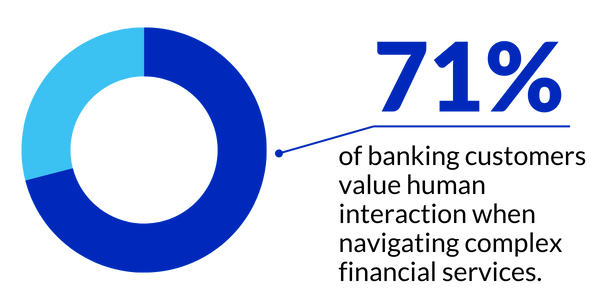Many in commercial lending are asking one question…
Why do commercial lenders still hesitate to make a technology switch?
After a period of transition and adjustment, commercial lending is going full steam ahead toward digital transformation. More and more commercial lenders are adopting digital technologies to streamline the lending process, customer experience, and more. While other spaces, including Finance, dug in against Industry 4.0 for some years, the balance has tipped, and digital momentum is building. It’s not only institutions that are learning to keep up; tech innovators themselves are turning their attention to the space to introduce new ideas and ways forward.
Why Now?
The Right Time for Digital in Commercial Lending
Commercial lending experienced growth rates in the double digits in the years following the crisis of 2008. Multifamily lending has proven to be a particularly dynamic area of growth since then, even having a strong year in 2021. A slowdown in Q4 of 2022 is not expected to create too much trouble moving into 2023 — while something of an abatement may happen, that is only in comparison to what was an outsized year in 2021.
What is clear is that 2023 will be a time of transition as CRE and their neighboring industries adjust to rising inflation and an evasive economy, with 2024 expected to be a time of settling. Case in point— the MBA just raised its forecast slightly for 2024, saying it expects commercial real estate originations to total around $906 billion, including $486 billion in multifamily loans.
NEW Checklist for Choosing an Automated Doc Prep System
Use this complete checklist to help evaluate and compare different automated loan doc systems for your needs.
Credit unions are continuing to be a force to reckon with— total commercial real estate production in the fourth quarter of 2022 was 54% less than in 2021 but fell only 27% among 25 credit unions. The lookout for private lending in 2023 continues to be positive, with experts anticipating the asset class to continue to claim a sizable chunk of market share in the months to come.
The CRE industry is experiencing a noteworthy uptick in the number of private lenders who are turning to digital platforms to automate loan document generation. By doing so, they aim to expedite the closing process, expand their lending operations into thriving markets, and capitalize on areas experiencing healthy pockets of growth.
 While these numbers are hugely positive, they do define a shifting, competitive landscape. As recently as 2020, large financial institutions and regional banks still dominated the market. In the last few years, however, fintech and smaller competitors in the digital space have redefined the industry, offering innovative tech, faster delivery, and an enhanced customer experience.
While these numbers are hugely positive, they do define a shifting, competitive landscape. As recently as 2020, large financial institutions and regional banks still dominated the market. In the last few years, however, fintech and smaller competitors in the digital space have redefined the industry, offering innovative tech, faster delivery, and an enhanced customer experience.
Any tech, however advanced, cannot fulfill its potential without dedicated user adoption. And while the momentum has shifted, some in CRE are still resisting. Why is it that some lenders are still hesitating to make a technology switch? There may be a number of factors at play.
Schedule a custom demo to learn more about GoDocs’ digital solution for loan document automation.
#1
Lenders don’t understand that the borrower expects digital transformation.
 Perhaps the time is now right for digital transformation in commercial lending for one reason and one reason alone— because the borrower now expects it.
Perhaps the time is now right for digital transformation in commercial lending for one reason and one reason alone— because the borrower now expects it.
Having experienced the elimination of pain points (and, frankly, often total delight) via digital technologies for years now, no borrower can be expected to tolerate analog, legacy solutions. That these legacy processes only drag out the timeline for everything from application to closing only compounds the issue. After all, today’s savvy commercial borrower expects things done well and quickly. Clients are ready to jump ship for institutions that offer innovation. Commercial lenders need to understand this and extend a frictionless client experience.
On the lender side, digital transformation is required to keep pace with competitors. To do that, lenders need a way to increase loan volumes without increasing staff and overhead. Digital solutions will allow commercial lenders to maintain their competitive edge without increasing operational costs.
#2
They’re convinced commercial lending is “too complex” for automation.
 The complexity of commercial lending processes is often cited as one reason to take things slowly when transitioning to the digital. By addressing these ‘complexities’ brick by brick, however, digital vendors are finding unique ways to transform the space.
The complexity of commercial lending processes is often cited as one reason to take things slowly when transitioning to the digital. By addressing these ‘complexities’ brick by brick, however, digital vendors are finding unique ways to transform the space.
Rather than generate holistic solutions, digital innovators in commercial lending are addressing individual processes. Vendors are digitizing and streamlining anything from the intake of documents during the loan approval process to documentation during closing.
As an example, one leader in automation, GoDocs, focuses on commercial loan document preparation. Built by seasoned commercial real estate attorneys, the solution provides a frictionless process for loan document preparation that is fully automated and requires no editing on the back end. By innovating on this single pain point in the commercial lending process, the company is able to address multiple sectors within commercial lending, including construction loans.
#3
They’re not thinking about diversification.
Digital technologies and automation are continuing to provide ways for lenders to improvise in a shifting economy. Avoiding digital transformation may well mean cutting yourself off from some much-needed opportunities and creative thinking in 2023.
Take construction as an example. In addition to addressing multifamily and C&I loans, loan document automation systems such as GoDocs come with a broad Construction Loan capability, including ground-up, fix & flip, major rehab, modest rehab, and minor rehab projects. Rehab provisions built into the integrated solution include detailed construction monitoring, disbursement controls, and mechanics lien protections.
As is often the case in commercial lending, construction lending operates within a framework of multiple moving parts, many of which can potentially operate at a slow pace. This includes lender identification, financing, loan processing, loan closing, progress reporting, draw disbursements, on-demand payments to contractors, and system integrations.
The Digital Era is Here
The time is now for digital transformation in commercial lending. This is the era in which borrowers have far more lender options for their CRE loans because of the exponential rise of private lenders. This is the era of unprecedented commercial loan volumes due to the boom in single-family rental property acquisitions by Goliath investors as well as legions of smaller investors. And this is the era where borrowers demand lower costs, faster closings, better experience, and all the other digital services that modern shoppers (and yes, borrowers are shoppers) have come to expect with every service today – they demand the digital experience.
This means they want digital services without losing any of the flexibility (loan types, financing and payment options, deal complexity, collateral complexity, etc.) required to complete a transaction.
End-to-end Transformation
 Transformation won’t be piecemeal. End-to-end digital solutions for commercial lending of all types, including commercial, multifamily, and 1-4 unit business purpose loans, regardless of their complexity, will drive the digital future in the space.
Transformation won’t be piecemeal. End-to-end digital solutions for commercial lending of all types, including commercial, multifamily, and 1-4 unit business purpose loans, regardless of their complexity, will drive the digital future in the space.
A true end-to-end solution will encompass lender identification, digital financing, and loan closing automation. These solutions, too, will integrate easily with existing workflows and processes, adapting to the demands of banks, credit unions, and private lenders. The solutions will also sidestep painful scenarios in which these institutions have to adopt new LOS and banking systems, thereby slowing adoption and delaying ROI.
Credit unions, for example, will benefit as dynamically as big banking institutions from this digital transformation. In the never-ending balancing act between risk and reward, credit unions will be able to leverage digital technologies to expand commercial lending and increase their regional impact. Digital solutions at credit unions will address member expectations around mobile and digital apps while also giving these institutions powerful ways to support mobile work internally.
State of the Industry — Seizing the Moment
Why Implementing Technology Now is Essential for Future Success
In today’s lending market, many lenders are seeking to reduce costs and staff due to the state of the industry. However, cutting technology subscriptions and avoiding new technology is not the right mindset to have. Instead, the focus should be on identifying which technologies to implement or utilize that can help adjust to market highs and lows without negatively impacting the business.
One example of such technology is automated closing documents. This technology can meet the demands of the industry during high and low times without requiring additional resources. By implementing this technology, lenders can operate with lean resources even during volume spikes, which helps to minimize the impact of cost-cutting measures on their business.
 There are several reasons why the right time is now to implement new or updated technology. Firstly, loan volume is currently on the slower side, making it an ideal time to prepare for a future resurgence. By having the technology in place now, lenders can be ready to handle increased volume when the market picks up again.
There are several reasons why the right time is now to implement new or updated technology. Firstly, loan volume is currently on the slower side, making it an ideal time to prepare for a future resurgence. By having the technology in place now, lenders can be ready to handle increased volume when the market picks up again.
Secondly, implementing new technology during downtimes can provide a significant return on investment. Technologies like loan document automation can generate pass-through profits, productivity savings, and accelerate interest revenue while also reducing attorney costs. Additionally, this technology can enable lenders to execute lending in new geographical areas for revenue expansion.
Lastly, implementing new technology during busy times when loan volume is up can overwhelm your team with the legacy process. Therefore, taking advantage of slower times to implement new technology can help ensure a smoother transition and better adoption rates.
Overall, the right mindset for lenders should be to identify the technology that can help them adjust to market highs and lows and implement it in a timely manner to minimize the impact of cost-cutting measures while maximizing profitability.
Staying Pace with Transformation
Prepare yourself for the coming market insurgence.
Of course, all success in this digital future depends on how adept lenders are at staying pace with transformation. The time is now to begin aligning with future practices. Automation is no longer a luxury but a necessity for entities in commercial lending. As lending continues to evolve through digital technologies, financial institutions will access more and more opportunities to increase loan volumes and revenue.
If lenders are not ready and must continue to lend in a mostly analog way (labor, high touch, lots of attorney time and expense), then competing will be harder than ever and customer retention will be harder than ever.

Myth 4: Switching to a new loan document solution will be just as frustrating as the last time.
Legacy loan closing systems have created misconceptions about what’s possible in commercial loan documentation. In

Myth 3: Switching systems is too disruptive.
Legacy loan closing systems have created misconceptions about what’s possible in commercial loan documentation. In

Myth 2: Closing document customization requires outside counsel.
Legacy loan closing systems have created misconceptions about what’s possible in commercial loan documentation. In





